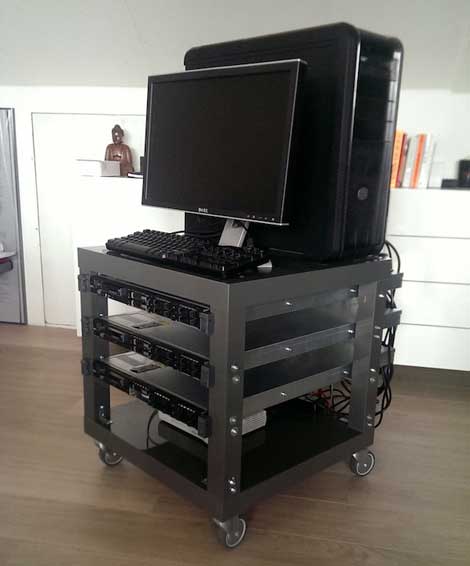The Home Data Center: Man Cave for the Internet AgeThe Home Data Center: Man Cave for the Internet Age
In the ultimate manifestation of the "server hugger" who wants to be close to their equipment, hobbyists and IT professionals have set up data centers in their home, creating server rooms in garages, basements and home offices.
August 27, 2014

In the ultimate manifestation of the "server hugger" who wants to be close to their equipment, a number of hobbyists and IT professionals have set up data centers in their home, creating server rooms in garages, basements and home offices.
The home data center is a novel extension of the central role that data centers now play in modern life. These enthusiasts are driven by a passion for IT, and use their gear for test-driving new equipment, lightweight web hosting or just as the ultimate technology ManCave.
Whatever the motivation, this level of connected house requires some adaptations, including upgrading power and network connections and running cable throughout a residential home.
Here's a look at a few examples of these projects:
The enterprise is in the house
Canadian IT professional Alain Boudreault has enterprise class equipment from Dell, HP, Sun, Juniper and IBM in his home data center in the basement of his house, including a high-density IBM BladeCenter. His web site provides a detailed overview of his setup, including a diagram of all the components. It includes an Open Stack MAAS (Metal as a Service) cloud and multiple storage systems (iSCSI and Fiber Channel).
"My first step was to install an electrical box to provide a power of 240 volts at 40 amp, which will provide a maximum of 9.6 kW/hour when needed, writes Boudreault, who teaches application development and uses the facility for testing. "The servers are rarely open all at once, so average consumption is 1-2 kW/hour." Electricity is about 7 cents per kW/hour in Quebec, he says.
Nonetheless, Boudreault writes that this type of home data center is "not for the faint of heart."
The data center as YouTube star
Some home data center builders post videos to YouTube. The most popular of these is the Home Data Center Project, another project in Canada that began in 2005 as two computers in a closet and had grown to more than 60 servers as of 2013. The project has been documented in a series of videos that have racked up more than 500,000 views on YouTube. The videos and web site document the extensive cabling, cooling and network infrastructure upgrades.

Racks of servers in a garage are part of the Home Data Center Project, which has been documented in videos with more than 500,000 views on YouTube. (Photo: Home Data Center Project).
"This project was not designed to make a profit," writes developer Etienne Vailleux of Hyperweb Technologies. "This setup was simply there as a hobby. But after some time, it quickly became a passion."
In 2013, the project migrated from one house to another and downscaled a bit. "A part of the basement was specially designed to house servers and air conditioners," Vailleux shared in an update. "The project is currently hosting 15 servers. The capacity of the connection is 60 Mbit/s."
About that bandwidth usage ...
Running racks of IT gear in your home sometimes gets noticed. In 2012 an IT professional known online as houkouonchi posted a video of his home rack that has been viewed more than 220,000 times on YouTube.
The setup is "not really a data center, but not many homes have a full sized rack with more than 150TB of space in it," he wrote. "The rack is bolted through the wood floor into the cement foundation the home sits on." The fully-packed rack uses only about 1 kW of power, but bandwidth is another matter.
In 2013 houkouonchi told Ars Technica that he had been contacted by Verizon, which was surprised to see a residential account using more than 50 terabytes of traffic per month. It turned out that hosting a high-volume media server violated the terms of service for a residential FiOS line, and he had to upgrade to a business plan.
Here's the tour of houkouonchi's rack:
The IKEA rack
Why use standard data center racks in your home, when you can house gear in a stylish side table from IKEA? In one of the more playful home data center implementations, hobbyists have adapted the Swedish furniture chain’s LACK side table to house servers and switches, creating a LACKRack. It turns out that the space between the table’s legs is 19 inches, the same width as a standard slot in a data center server rack.
The server space is created by using wood screws to affix rack mounts to the legs of the table. The tables are stackable and modular, so can be assembled in a variety of configurations.

An implementation of the LACKRack, which adapts an IKEA side table for use as a stylish home data center.
Since its first appearance in 2010, the Lack Rack has spurred design innovations. Frank Dennemen, the technology evangelist for PernixData, adapted the initial Lack Rack spec to create a portable 19-inch rack.
"My home office is designed to be an office and not a datacenter," writes Denneman. "So where do you place 19” rack servers without ruining the esthetics of your minimalistic designed home office? Well you create a 19” rack on wheels so you can role it out of sight and place it wherever you want it." Check out the end result:

This portable IT rack was adapted from an IKEA Lack side table. Photo: Frank Denneman.
Do you know of any other crazy home data center setups? Perhaps at your house? If so, please share your links and experiences in the comments!
About the Author
You May Also Like







